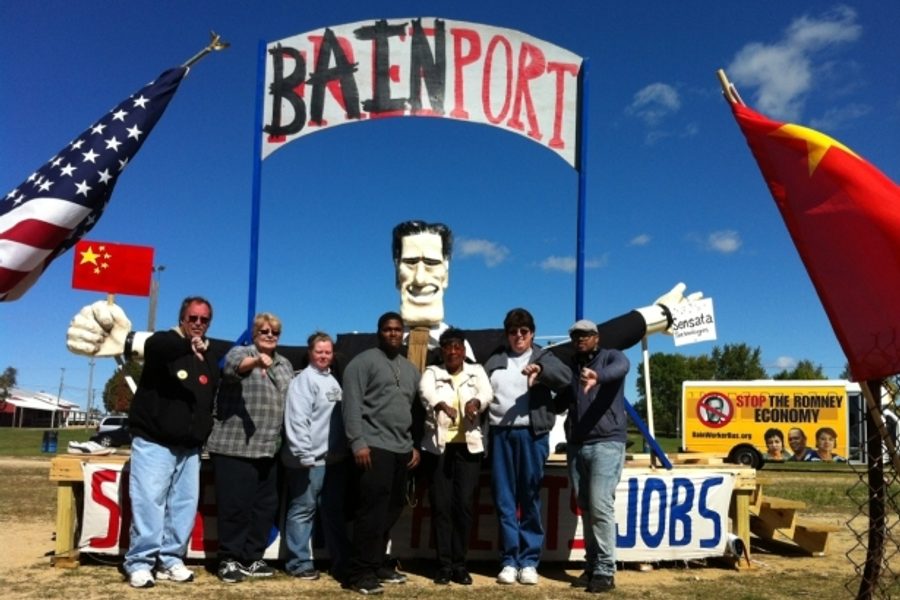On Monday, the Bain Capital-owned Sensata factory in Freeport, Ill. laid off 20 of its remaining 50 workers as it prepares to shut its door permanently in December. Many workers have engaged in high-profile demonstrations to protest the plant closing, and some have been arrested. One focus of the protests has been to draw attention to the fact that Mitt Romney founded Bain Capital and still owns stock both Sensata and Bain. Union leaders and Democrats have urged Romney to speak up in order to stop the plant from closing.
“He [Romney] is running for president,” Democratic Freeport Mayor George Gaulrapp told the Huffington Post. “These people felt it was a little hypocritical that he was with Bain Capital, he organized some of the processes, and now he’s touring the country … saying we need to keep jobs here in the United States. And yet for a long time, he made a lot of profits by tearing companies apart and sending them overseas.”
However, it may be that Mayor Gaulrapp and the other Democrats in control of local government are actually the ones with the power to halt the plant closure. Theoretically, the mayor and the Freeport city council, which has passed a resolution denouncing the plant closing, could jointly declare eminent domain to save the factory. The town would then compensate Sensata for the factory at a fair market price and try to sell it to another company.
Commonly, eminent domain is invoked to help big business by kicking people out of their homes to make way for corporations such as a Walmart. But in a handful of instances throughout the United States, unions have successfully saved factories by convincing local towns to invoke eminent domain.
“Local governments have extraordinary powers through eminent domain to confiscate private property in order to use for the public good, and they should be doing it,” says United Electrical, Radio and Machine Workers of America (UE) Northeast President Peter Knowlton, who saved the Morse Cutting Tool plant from closing by getting the city of New Bedford to threaten eminent domain in 1984. “Over time, these workplaces become public domain. They don’t belong to anyone person. At some point, they just become part of the public fabric just as much as a beach or a park or public land. It becomes property of the community.”
Two years ago, I traveled up to Taunton, Mass., where Knowlton, a tall, wiry organizer with a thick Boston accent, was trying to repeat his success. He was leading a group of workers in lobbying the city council to declare eminent domain and take over an Esterline factory that was slated to be closed, its 100 workers laid off.
For over 80 years, the Esterline-owned plant had manufactured aircraft doors under five different owners. Although the operation was profitable, the company decided in the summer of 2010 to close the unionized plant, citing under-capacity at its non-union facilities in Mexico and California. In order to keep competitors from entering the market, Esterline refused to sell the factory to any of several interested buyers, instead planning to sell off the remaining equipment for scrap metal prices.
“We are under attack big time, but boy are we going to put up a fight,” Knowlton told me. Later that day, the mayor and city council of Taunton voted unanimously to instruct the city solicitor to take the first step toward declaring eminent domain – requesting that the state legislature issue a Home Rule Petition to take over Esterline’s equipment.
Eminent domain, often called the third rail of local politics, is a controversial and high-stakes strategy. Under the Fifth Amendment of the U.S. Constitution, the government can claim private property for “public purposes” without the consent of the owner as long as the owner is compensated at fair market value. In the 1949 case Kimball Laundry Company v. United States, the Supreme Court ruled that the Fifth Amendment allows government to take over private businesses, such as factories.
In perhaps the most famous example of a community using eminent domain to stop a business from moving out of town, the Maryland House of Delegates passed a law in March of 1984 approving of the seizure of the Baltimore Colts in order to prevent that team from moving to Indianapolis. The next day, the state Senate was scheduled to approve the eminent domain seizure, but before they could vote, in the early morning hours of March 29, 1984, the owners of the Baltimore Colts packed the team’s belongings into moving trucks and drove to Indianapolis.
Local coercive action to keep factories open is far more common in Europe and Latin America than in the United States. For example, during Argentina’s economic collapse of 2002, workers responded to factory closures by occupying hundreds of factories and operating them as cooperatives. In the United States, the closest analogue is the 2008 occupation of the Republic Windows and Doors factory in Chicago by UE members. As a result of the occupation, workers were able to win full severance pay. Thanks to the media attention they garnered, they also successfully found an investor to buy the plant and keep it open. The plant then closed a second time in 2012, and workers once again occupied and negotiated a deal that allowed them to keep it open as cooperative.
UE has had success using the threat of eminent domain since the 1980s, when the union stopped the Morse Tool Cutting factory from closing. With the help of Barney Frank, they also led an effort to get the city council of New Bedford to declare eminent domain to stop another factory closing — J.C. Rhodes — in 1996. However, the factory ultimately closed because the union was betrayed by a veto from Mayor Rosemary Tierney, who was afraid of scaring business.
Eminent domain is one of a variety of legal tools that local governments have used to keep plants from leaving. Economic development subsidies also give local government a right to claim assets to keep them in the city while these subsidies are still in effect, according to an article by Kary L. Moss in the Fordham Urban Law Journal. In 1988, the City of Duluth, Minn. successfully sued Diamond Tool to keep its plant open based on the terms of an industrial revenue bond contract. They were able to keep the factory open for another six years — enough time for many of its workers to qualify for pensions and retire.
“Look, you look at most of these plants and they have received big tax breaks over the years. They have received investment in infrastructure to make the plant successful,” says Knowlton. “At a certain point you gotta ask yourself with so much public investment going into the plant, who owns these plants after all.”
Often when plants close, unions engage in symbolic protests, sometimes setting up picket lines like the workers at the Sensata plant in Freeport. The public pressure may sometimes lead the company to give workers a slightly better severance package, so as to not harm its reputation too much and keep things under wraps, but rarely do the workers gain the leverage to negotiate the acquisition of the company’s profit. Even if another company is interested in buying the plant, companies refuse to sell their plants in operating conditions in order to keep potential rivals out of the market (as in the case of a Georgia Pacific plant in Duluth, Minn. that closed in October).
That’s where eminent domain comes in.
“There are only two ways that a company changes its mind about selling a plant: Either the workers occupy the plant or declare eminent domain. What the Sensata workers are doing is sending a powerful message that hurts Bain Capital’s brand, but these guys calculate this stuff and they realize they can ride it out,” says Knowlton. “You gotta do something legally or physically to stop a plant from shutting down and moving. The two plants that we have saved, Morse Tool and Republic Windows and Doors were each saved that way. Morse Tool through an eminent domain fight and Republic Windows and Doors through a worker occupation.”
For a variety of reasons, the threat of eminent domain is rarely if ever used to fight factory closings. There are high legal hurdles, and the eminent domain order can be challenged in court – or owners, as in the case of the Baltimore Colts, can simply move their equipment out in the middle of the night. The bigger hurdles, though, are an American deference to private property rights and a lack of imagination about challenging corporations through laws that are currently on the books.
Townsend is quick to point out that this failure has tangible results: “People are going to see their lives ruined as a result of this factory closing — divorces, suicide, broken homes.” The Chief Union Steward at the plant, Victor Vasconcelos was hospitalized with chest pain as a result of anxiety the day before the city council voted to being eminent domain procedures. One young worker expressed anxiety that if he wasn’t able to save his job his wife would most likely divorce him. “Who cares about using eminent domain or occupying a factory and breaking the law if lives are going to be broken if that factory leaves town?” exclaims Townsend.
The workers at Esterline ultimately lost their battle. The Taunton town council’s request for a Home Rule Petition got bottled up in the Massachusetts State Legislature, and the plant was closed, the equipment sold for scrap metal. However, eminent domain still has the potential to prevent plant closings throughout the United States.
“I think you are going to see more of this kind of thing as our economic crisis deepens,” says Scott Paul. Paul is the director of the Alliance for American Manufacturing, a mild-mannered, research-based coalition of manufacturing business and trade unions. “[Eminent domain] captures the attention of the masses because a lot of people feel that a policy solution will never come from [Washington] DC. Based on what I have seen these last few years in DC, I feel maybe they are right; the policy solutions do seem pretty limited.”
It seems that the biggest barrier to use of eminent domain is not a lack of desire – workers are desperate to save their jobs – but of knowledge. When I called up one of the leaders of the group of non-union Sensata workers attempting to save their jobs, Tom Gaulrapp (no relation to Mayor Gaulrapp), whose plant is slated to close on December, said he hadn’t even heard of eminent domain.
“We hadn’t thought about that. That might be something to discuss with the mayor of the town. It’s a good idea,” says Tom Gaulrapp. “We are look at all options. Good jobs like this don’t exist in Midwestern cities.”
Perhaps a successful eminent domain fight to save the Sensata plant, one of the most well publicized plant closures in years, could start a new wave of workers using existing legal tools instead of merely begging for scraps in severance negotiations.









